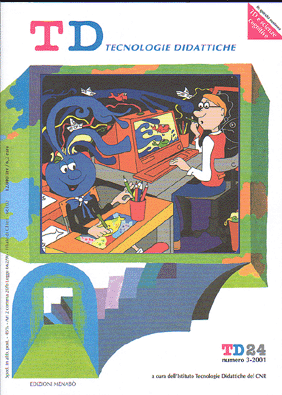Editorial
Main Article Content
Abstract
Article Details
Authors who publish with this journal agree to the following terms:
- Authors retain copyright and grant the journal right of first publication with the work simultaneously licensed under a Creative Commons CC BY 4.0 Attribution 4.0 International License.
- Authors are able to enter into separate, additional contractual arrangements for the non-exclusive distribution of the journal's published version of the work (e.g., post it to an institutional repository or publish it in a book), with an acknowledgement of its initial publication in this journal.
- Authors are permitted and encouraged to post their work online (e.g., in institutional repositories or on their website) prior to and during the submission process, as it can lead to productive exchanges, as well as earlier and greater citation of published work (See The Effect of Open Access)
References
Ausubel D. (1983), Educazione e processi cognitivi, Franco Angeli, Milano (ed. or. Ausubel D., Novak J., Hanesian H., Educational Psychology: A Cognitive View, 2nd ed., Holt, Rinehart & Winston, New York, 1978).
Bereiter C., Scardamalia M. (1989), Intentional Learning as a Goal of Instruction, in Resnick L. B. (ed), Knowing Learning and Instruction, Lawrence Erlbaum Associated inc., Hillsdale, New Jersey, pp. 361-392).
Brown A. L., Campione J. C. (1994), Guided Discovery in a Community of Learners, in Mc- Gilly K. (ed), Classroom Lesson: Integrating Cognitive Theory and Classroom Practice, MIT Press, Cambridge, MA, pp. 229-270).
Bruner J. (1992), La ricerca del significato. Per una psicologia culturale, Bollati Boringhieri, Torino (ed. or. Acts of Meaning, Harvard University Press, Cambridge, MA, 1990).
Dreyfus H. L. (1988), Che cosa non possono fare i computer. I limiti dell’intelligenza artificiale, Armando, Roma (ed. or. What Computers Can’t Do. The Limits of Artificial Intelligence, Harpers & Row Publishers Inc., New York, 1972, 1979).
Eisenberg N. (ed) (1986), Altruistic emotion, cognition and behavior, Lawrence Erlbaum Associates Inc., Hillsdale, New Jersey.
Engeström Y. (1987), Learning by expanding: An activity-theoretical approach to developmental research, Orienta-Konsultit Oy, Helsinki.
Harel I. e Papert S. (eds) (1991), Constructionism, Ablex Publishing, Norwood, NJ.
Lave J., Wenger E. (1991), Situated learning: Legitimate Peripheral Participation, Cambridge University Press, Cambridge.
Marconi D. (2001), Filosofia e scienza cognitiva, Laterza, Roma- Bari.
Newell A., Simon H. A. (1989), La scienza del computer come indagine empirica: simboli e ricerca, in Haugeland J. (a cura di), Progettare la mente, Il Mulino, Bologna, pp. 43-75.
Norman D. A. (2000), Il computer invisibile. La tecnologia migliore è quella che non si vede, Apogeo, Milano (ed. or. The invisible computer, MIT Press, Cambridge, MA, 1998).
Olimpo G. (1993), Nascita e sviluppi delle tecnologie didattiche, TD - Tecnologie Didattiche, n. 1, pp. 23-34.
Penna M. P., Pessa E. (2000), Manuale di scienza cognitiva. Intelligenza artificiale classica e psicologia cognitiva, Laterza, Bari-Roma.
Simon H. A. (1980), Cognitive Science: The Newest Science of the Artificial, Cognitive Science, n.4, 1980, p. 34.
Sleeman D., Brown J. S. (eds) (1982), Intelligent tutoring systems, Academic Press, London.
Suppes P. (1980), The teacher and computer-assisted instruction, in Taylor R. (ed), The computer in the school: Tutor, tool, tutee, Teachers College Press, New York, pp. 231-235.
Varisco B. M. (1995), Paradigmi psicologici e pratiche didattiche con il computer, TD - Tecnologie Didattiche, n. 7, pp. 57- 68.
Varisco B. M. (2000), Nuove tecnologie tra teoria e pratica didattica: le teorie a supporto della multimedialità, in Albanese O., Migliorini P., Pietrocola G. (a cura di), Apprendimento e nuove strategie educative, Unicopli, Milano.
Winograd T., Flores F. (1987), Calcolatori e conoscenza. Un nuovo approccio alla progettazione delle tecnologie dell’informazione, Mondadori, Milano (ed. or. Understanding Computers and Cognition. A New Foundation for Design, Ablex Publishing, Norwood, N.J., 1986).

